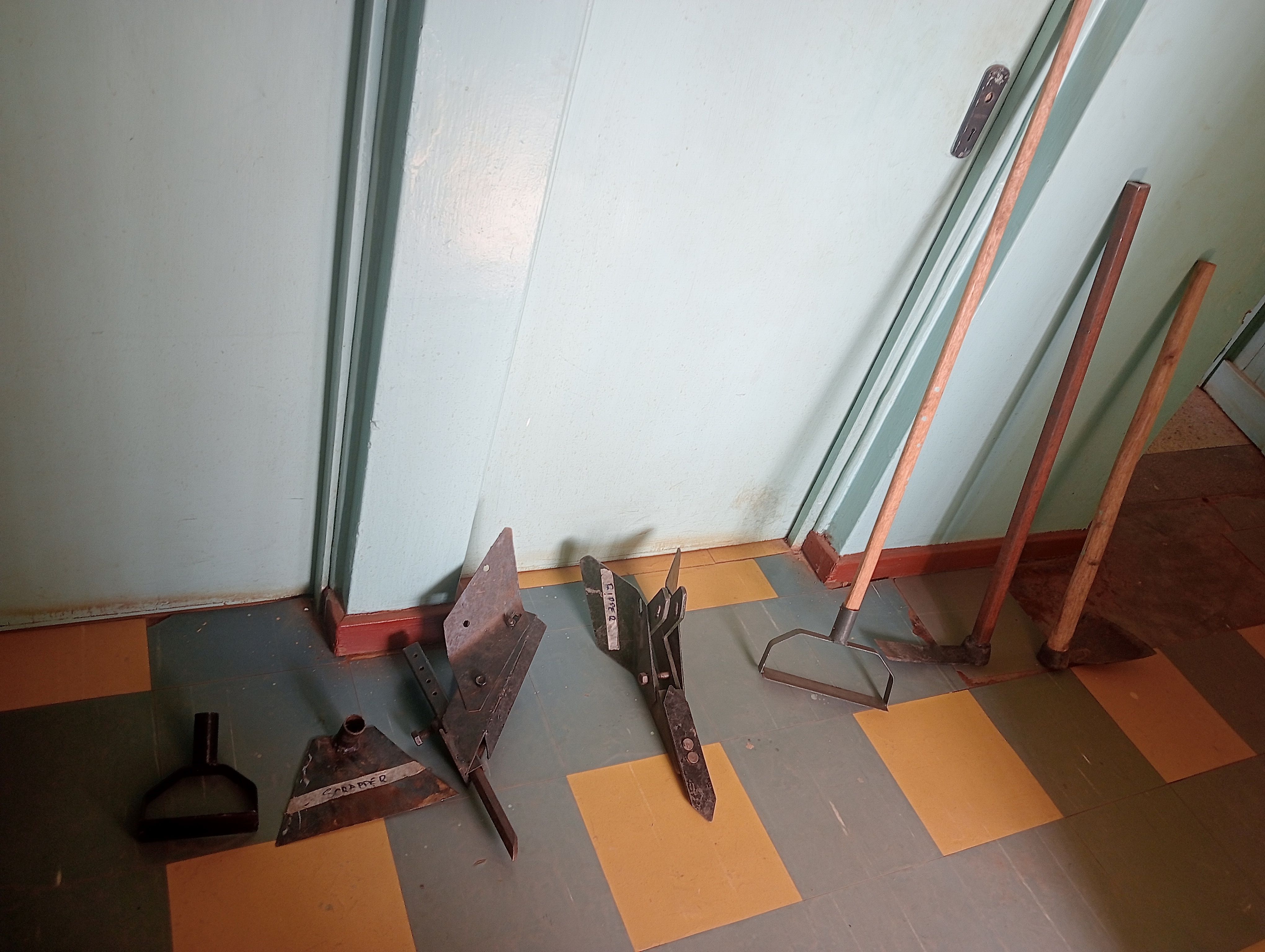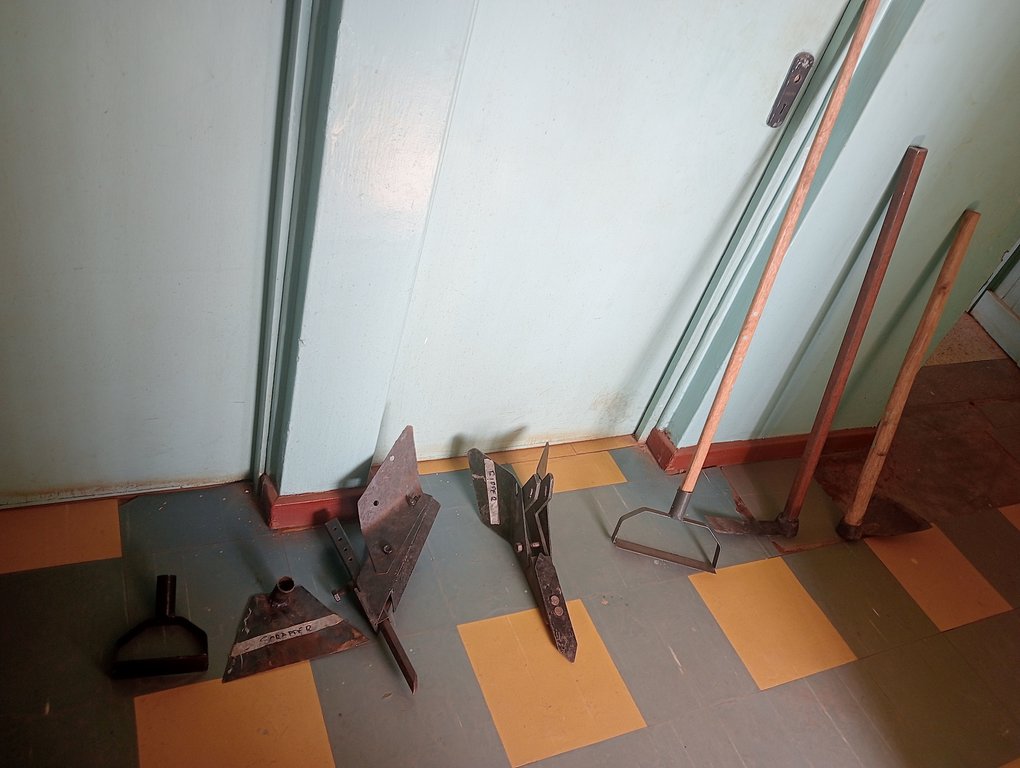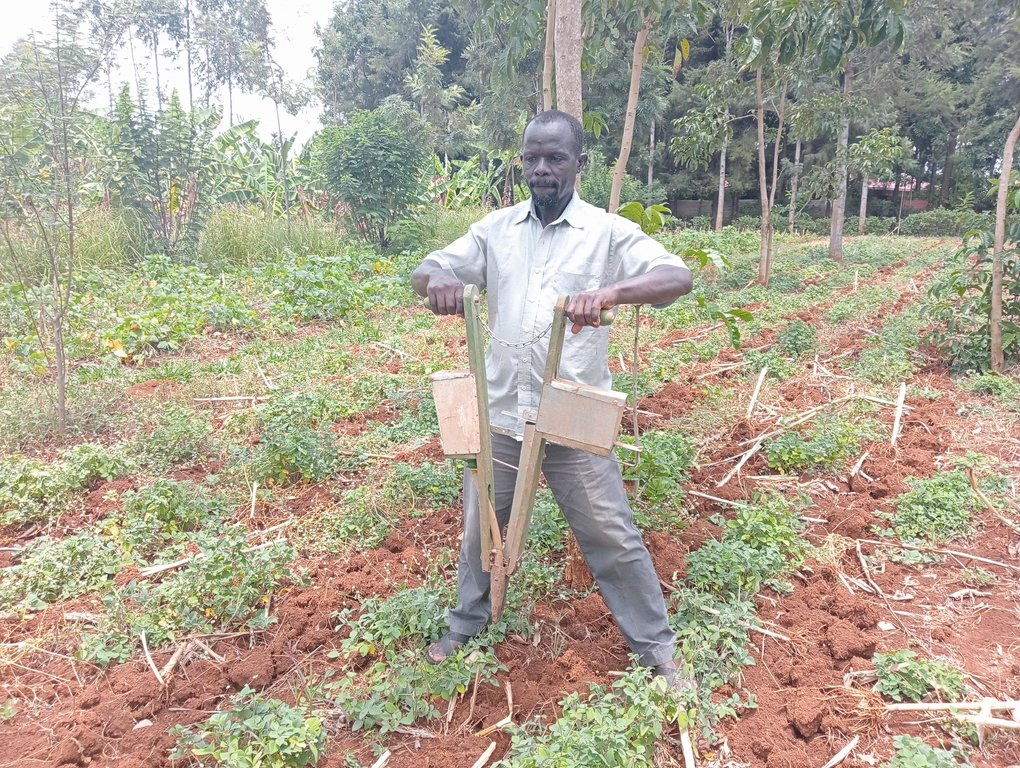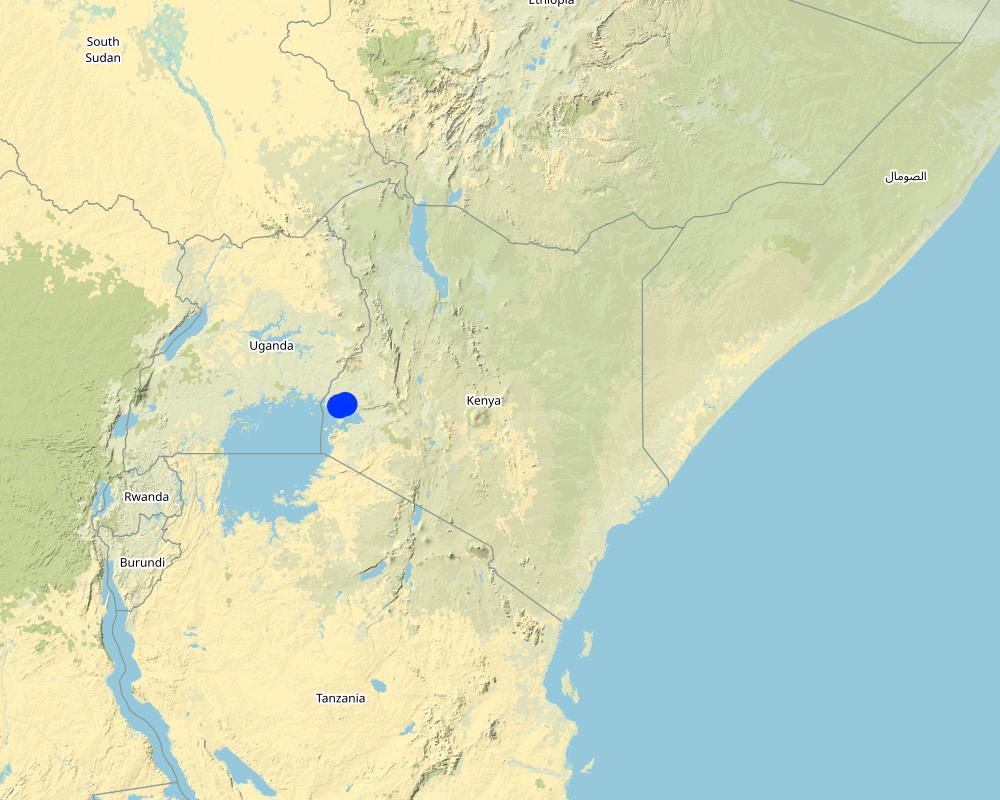Improving farmers' access to tools for conservation agriculture [Kenya]
- Création :
- Mise à jour :
- Compilateur : William Akwanyi
- Rédacteurs : Christopher Nyakan, Christopher Nyakan, Innocent Faith, Noel Templer
- Examinateurs : William Critchley, Rima Mekdaschi Studer
Kuendeleza kilimo hifadhi
approaches_6738 - Kenya
Voir les sections
Développer tout Réduire tout1. Informations générales
1.2 Coordonnées des personnes-ressources et des institutions impliquées dans l'évaluation et la documentation de l'Approche
Personne(s) ressource(s) clé(s)
exploitant des terres:
Ong'anda William Ouma
+254 722 236015 / +254 733 529508
GFA farmer
William Ong'anda's farm in Umoyo Village, Gem North Ward, Gem Yala Sub-county, in Siaya County
Kenya
Spécialiste GDT:
Opiyo Elizaphat
+254 718 288816
opiyoelizaphat@gmail.com
Rural Energy and Food Security Organization (REFSO)
Kenya
Spécialiste GDT:
Khasakhala Eboche Dave
+254 721 569842
khasakhalaedo@yahoo.com
Agricultural Technology Development Centre (ATDC), Siaya
Agricultural Technology Development Centre (ATDC), Siaya
Kenya
Spécialiste GDT:
Spécialiste GDT:
Nom du projet qui a facilité la documentation/ l'évaluation de l'Approche (si pertinent)
Soil protection and rehabilitation for food security (ProSo(i)l)Nom du ou des institutions qui ont facilité la documentation/ l'évaluation de l'Approche (si pertinent)
Deutsche Gesellschaft für Internationale Zusammenarbeit (GIZ)Nom du ou des institutions qui ont facilité la documentation/ l'évaluation de l'Approche (si pertinent)
Alliance Bioversity and International Center for Tropical Agriculture (Alliance Bioversity-CIAT) - Kenya1.3 Conditions relatives à l'utilisation par WOCAT des données documentées
Quand les données ont-elles été compilées (sur le terrain)?
11/03/2023
Le compilateur et la(les) personne(s) ressource(s) acceptent les conditions relatives à l'utilisation par WOCAT des données documentées:
Oui
1.4 Références au(x) questionnaire(s) sur les Technologies de GDT
2. Description de l'Approche de GDT
2.1 Courte description de l'Approche
Improving farmers' access to minimum tillage tools is an approach to increasing the adoption of conservation agriculture (CA) through linking them to institutions that fabricate the tools.
2.2 Description détaillée de l'Approche
Description détaillée de l'Approche:
Using minimum tillage tools in land preparation, planting, and weed management helps to achieve the principle of minimal soil disturbance in conservation agriculture (CA). However, one of the main challenges facing the adoption of minimum tillage is the high cost of minimum tillage tools. In this approach, the ProSoil project sought to overcome the challenges of accessibility to and high cost of minimum tillage tools. GIZ through Gesellschaft für Agrarprojekte in Übersee (GFA) collaborated with the County Departments of Agriculture’s Agricultural Technology Development Centers (ATDCs) to train local artisans (welders) on how to fabricate minimum tillage tools at reduced cost and ensure easy access. Currently, the farmers can order hand-held minimum tillage tools such as jab planters, hand-held scrapers, shallow weeders, hand-held subsoilers, animal draft power (ADP) subsoilers, ADP rippers, and chaka hoes from ATDCs and local fabricators at reduced costs. In addition, farmers with large pieces of land can hire heavy minimum tillage implements from ATDCs at affordable rents. The project has also partnered with the Kenya Agricultural and Livestock Research Organization (KALRO) to ensure continuous research on the minimum tillage tools and how to improve them based on the different farm settings.
To increase knowledge about minimum tillage, GFA facilitated local community-based organizations to train farmers on the importance of minimum tillage and how to use minimum tillage tools. In Gem Yala area of Siaya County, Kenya, GFA partnered with Rural Energy and Food Security Organization (REFSO) to offer these pieces of training to the farmers through their groups and link them to local manufacturers. Each group consisted of about 25 farmers of which at least 30% were women. The trainings take place at designated venues in localities that are easily accessible by farmers from different locations.
Farmers like this approach because they have been linked to the manufacturers of the tools and have had their capacity built on how to use the tools. They are therefore able to access the tools easily and at affordable prices. They are also motivated to adopt minimum tillage after having benchmarked in other farms are seen how minimum tillage has improved production.
2.3 Photos de l'approche
2.4 Vidéos de l'Approche
Commentaire, brève description:
A farmer demonstrating how to use a chaka hoe
https://www.youtube.com/watch?v=LMgULi30Jso&ab_channel=WilliamOnura
Date:
11/03/2023
Lieu:
William Ong'anda's farm in Umoyo Village, Gem North Ward, Gem Yala Sub-county, in Siaya County
Nom du vidéaste:
William Onura
Commentaire, brève description:
A farmer demonstrating how to use a jab planter
https://www.youtube.com/watch?v=1bxoc5IL_pM&ab_channel=WilliamOnura
Date:
11/03/2023
Lieu:
William Ong'anda's farm in Umoyo Village, Gem North Ward, Gem Yala Sub-county, in Siaya County
Nom du vidéaste:
William Onura
Commentaire, brève description:
A farmer demonstrating how to use a shallow weeder
https://www.youtube.com/watch?v=HMFrEybintM&ab_channel=WilliamOnura
Date:
11/03/2023
Lieu:
William Ong'anda's farm in Umoyo Village, Gem North Ward, Gem Yala Sub-county, in Siaya County
Nom du vidéaste:
William Onura
2.5 Pays/ région/ lieux où l'Approche a été appliquée
Pays:
Kenya
Région/ Etat/ Province:
Siaya County, Nyanza Region
Autres spécifications du lieu :
Gem North Ward in Gem Yala Sub-county
Map
×2.6 Dates de début et de fin de l'Approche
Indiquez l'année de démarrage:
2020
Commentaires:
The approach is still in use.
2.7 Type d'Approche
- fondé sur un projet/ programme
2.8 Principaux objectifs de l'Approche
Aim: To increase the adoption of conservation agriculture (CA).
Objective: To improve farmers' access to minimum tillage tools.
2.9 Conditions favorisant ou entravant la mise en œuvre de la(des) Technologie(s) appliquée(s) sous l'Approche
normes et valeurs sociales/ culturelles/ religieuses
- favorise
Most farmers have accepted the technology.
disponibilité/ accès aux ressources et services financiers
- favorise
Less capital investments in maintaining the technologies under the approach.
collaboration/ coordination des acteurs
- favorise
Collaboration with Kenya Agricultural, Livestock Research Organisation (KALRO) and Agricultural Technology and Development Centres (ATDC), local artisans, farmer groups, and Rural Energy and Food Security Organization (REFSO) in tool production and training.
connaissances sur la GDT, accès aux supports techniques
- favorise
Working together with partners from the county department of agriculture to increase awareness about the tools.
- entrave
Not preferred by farmer who want to have benefits in the short term.
charge de travail, disponibilité de la main-d'œuvre
- favorise
Reduced workload in the long run.
3. Participation et rôles des parties prenantes impliquées dans l'Approche
3.1 Parties prenantes impliquées dans l'Approche et rôles
- exploitants locaux des terres / communautés locales
Farmers - men, women, and youth.
Targeted by the technologies and implement them.
- organisations communautaires
Umoya Farmers Self-Help Group
Convening farmers during trainings.
- Spécialistes de la GDT/ conseillers agricoles
SLM specialists from the ProSoil project, Rural Energy and Food Security Organization (REFSO) and the Agricultural Technology Development Centre (ATDC).
Technical support and advisories to farmers i.e., pass the SLM knowledge to the community resource persons in the community.
- chercheurs
Kenya Agricultural and Livestock Research Organization (KALRO)
Continuous research on the CA tools and how to improve them based on the different settings.
- secteur privé
Rural Energy and Food Security Organization (REFSO)
Worked hand-in-hand with other SLM specialists to pass the SLM knowledge to the farmers.
- gouvernement local
Agricultural extension officers from the county government department of agriculture i.e., the Agricultural Technology Development Centre (ATDC).
Worked hand-in-hand with other SLM specialists to pass the SLM knowledge to the farmers.
- organisation internationale
GIZ
Proposal design and financial support to the implementation of the approach.
Si plusieurs parties prenantes sont impliquées, indiquez l'organisme chef de file ou l'institution responsable:
GIZ
3.2 Participation des exploitants locaux des terres/ communautés locales aux différentes phases de l'Approche
| Participation des exploitants locaux des terres/ communautés locales | Spécifiez qui était impliqué et décrivez les activités | |
|---|---|---|
| initiation/ motivation | passive | Farmers in the community, targeted by the SLM technologies under the approach and awareness on access to the minimum tillage tools. |
| planification | interactive | Agricultural Technology Development Centre (ATDC) and Rural Energy and Food Security Organization (REFSO) jointly agree with farmers on when to engage each other, especially time and venue for training and awareness creation on access to tools. |
| mise en œuvre | auto-mobilisation | Once trained, farmers implement the SLM technologies on their own, but may seek further advice from the SLM specialists where necessary. |
| suivi/ évaluation | passive | The planning for and conduct of monitoring and/ or evaluation is a role of GIZ and WHH. Farmers are mainly interviewed based on pre-determined questions. |
| Research | interactive | Continued research by ATDC and KALRO in consultation with farmers to develop tools that are suitable for different settings/ farmlands. |
3.3 Diagramme/ organigramme (si disponible)
Description:
The ProSoil (GIZ and WHH) provides financial support for research by the Kenya Agricultural and Livestock Researchj Organization (KALRO) and for training of farmers by Rural Energy and Food Security Organization (REFSO) and of local artisans by the Agricultural Technology Development Centre (ATDC). Umoya Farmers Self-Help Group convenes farmers for training.
Auteur:
William Akwanyi
3.4 Prises de décision pour la sélection de la Technologie/ des Technologies
Indiquez qui a décidé de la sélection de la Technologie/ des Technologies à mettre en œuvre:
- tous les acteurs concernés dans le cadre d'une approche participative
Expliquez:
Decisions on what SLM technologies to implement were made mainly by most partners i.e., GIZ, GFA, KALRO, ATDC, REFSO, and the farmers.
Spécifiez sur quelle base ont été prises les décisions:
- l'évaluation de connaissances bien documentées en matière de GDT (prises de décision fondées sur des preuves tangibles)?
- les résultats de recherches?
4. Soutien technique, renforcement des capacités et gestion des connaissances
4.1 Renforcement des capacités/ formation
Une formation a-t-elle été dispensée aux exploitants des terres/ autres parties prenantes?
Oui
Spécifiez qui a été formé:
- exploitants des terres
- personnels/ conseillers de terrain
- Local artisans
Si pertinent, spécifiez le genre, l'âge, le statut, l'ethnie, etc.
Farmers in their groups (Umoya Farmers Self-Help Group), about 25 farmers in a group, and at least 30% of the number were women.
Formats de la formation:
- sur le tas
- entre agriculteurs (d'exploitants à exploitants)
- zones de démonstration
Thèmes abordés:
1. Benefits of conservation agriculture - minimum tillage
2. Different types of minimum tillage tools
3. How to use different minimum tillage tools
4. Linkage to minimum tillage tools fabricators
4.2 Service de conseils
Les exploitants des terres ont-ils accès à un service de conseils?
Oui
Spécifiez si le service de conseils est fourni:
- dans les champs des exploitants?
- dans des centres permanents
Décrivez/ commentez:
SLM specialists advise farmers at their farms whenever they visit them. Farmers can also visit ATDC, KALRO, and REFSO offices for advice. Farmers are also trained at designated venues in groups.
4.3 Renforcement des institutions (développement organisationnel)
Des institutions ont elles été mises en place ou renforcées par le biais de l'Approche?
- oui, modérément
Spécifiez à quel(s) niveau(x), ces institutions ont été renforcées ou mises en place:
- local
Décrivez l'institution, ses rôles et responsabilités, ses membres, etc.
About 10 REFSO SLM specialists have been capacity built/ trained.
Précisez le type de soutien:
- renforcement des capacités/ formation
Donnez plus de détails:
Training on CA, its benefits, and how and where to access CA tools.
4.4 Suivi et évaluation
Le suivi et l'évaluation font ils partie de l'Approche? :
Oui
Commentaires:
GIZ and GFA regularly follows up with local artisans and the Agricultural Technology Development Centre (ATDC) to check on the number of farmers who have bought/ access minimum tillage tools.
Si oui, ce document est-il destiné à être utilisé pour le suivi et l'évaluation?
Non
Commentaires:
This documentation in intended for keeping a record of SLM technologies and approaches.
4.5 Recherche
La recherche a-t-elle fait partie intégrante de l’Approche?
Oui
- Tool suitability
Donnez plus de détails et indiquez qui a mené ces recherches:
Research was done by the Agricultural Technology Development Centre (ATDC) and the Kenya Agricultural and Livestock Research Organization (KALRO) to determine which minimum tillage tools are suitable for which farm settings.
5. Financement et soutien matériel externe
5.1 Budget annuel de la composante GDT de l'Approche
Si le budget annuel précis n'est pas connu, indiquez une fourchette:
- 100 000-1 000 000
Commentez (par ex. principales sources de financement/ principaux bailleurs de fonds):
Training costs met by GIZ ProSoil project. The cost covers training of a group of about 25 farmers and a group of about 20 local fabricators, and research in tool suitability.
5.2 Soutiens financiers/ matériels fournis aux exploitants des terres
Les exploitants des terres ont-ils reçu un soutien financier/ matériel pour la mise en œuvre de la Technologie/ des Technologies?
Oui
Si oui, spécifiez le(s) type(s) de soutien, les conditions et les fournisseurs:
GIZ through GFA supported farmers in their groups with minimum tillage tools for demonstration purposes.
5.3 Subventions pour des intrants spécifiques (incluant la main d'œuvre)
- équipement
| Spécifiez les intrants subventionnés | Dans quelle mesure | Spécifiez les subventions |
|---|---|---|
| outils | entièrement financé | GIZ through GFA supported farmers in their groups with CA tools for demonstration purposes. |
Si la main d'œuvre fournie par les exploitants des terres était un intrant substantiel, elle était:
- volontaire
Commentaires:
Farmers provided labour at demonstration plots.
5.4 Crédits
Des crédits ont-ils été alloués à travers l'Approche pour les activités de GDT?
Non
5.5 Autres incitations ou instruments
D'autres incitations ou instruments ont-ils été utilisés pour promouvoir la mise en œuvre des Technologies de GDT?
Non
6. Analyses d'impact et conclusions
6.1 Impacts de l'Approche
Est-ce que l'Approche a autonomisé les exploitants locaux des terres, amélioré la participation des parties prenantes?
- Non
- Oui, un peu
- Oui, modérément
- Oui, beaucoup
Farmers have been empowered with skills on how to use minimum tillage tools and where and how to access them.
Est-ce que l'Approche a permis la prise de décisions fondées sur des données probantes?
- Non
- Oui, un peu
- Oui, modérément
- Oui, beaucoup
Demonstration/ learning plots were important in enabling farmers to learn from the practitioners and from each other based on evidence.
Est-ce que l'Approche a aidé les exploitants des terres à mettre en œuvre et entretenir les Technologies de GDT?
- Non
- Oui, un peu
- Oui, modérément
- Oui, beaucoup
Farmer were trained on minimum tillage.
Est-ce que l'Approche a amélioré la coordination et la mise en œuvre de la GDT selon un bon rapport coût-efficacité?
- Non
- Oui, un peu
- Oui, modérément
- Oui, beaucoup
The Agriculture Technology Development Centre (ATDC) trained local artisans on how to fabricate minimum tillage tools and sells them to farmers at a lower price than that in the other farmers' shops.
Est-ce que l'Approche a amélioré les connaissances et les capacités des exploitants des terres pour mettre en œuvre la GDT?
- Non
- Oui, un peu
- Oui, modérément
- Oui, beaucoup
Farmer were taken through pieces of trainings on how to use the minimum tillage tools.
Est-ce que l'Approche a amélioré les connaissances et les capacités des autres parties prenantes?
- Non
- Oui, un peu
- Oui, modérément
- Oui, beaucoup
Local artisans were trained on how to fabricate minimum tillage tools.
Est-ce que l'Approche a construit/ renforcé les institutions, la collaboration entre parties prenantes?
- Non
- Oui, un peu
- Oui, modérément
- Oui, beaucoup
Collaboration between farmers and public extension officers i.e., Agriculture Technology Development Centre (ATDC) SLM specialists. More farmers are consulting these officers for advice.
Est-ce que l'Approche a autonomisé les groupes socialement et économiquement défavorisés?
- Non
- Oui, un peu
- Oui, modérément
- Oui, beaucoup
The minimum tillage tools provided to the farmers in their groups are used by farmers who cannot afford to buy the tools.
Est-ce que l'Approche a conduit à des emplois, des opportunités de revenus?
- Non
- Oui, un peu
- Oui, modérément
- Oui, beaucoup
More local artisans were trained on the fabrication of minimum tillage tools. They sell these tools to farmers and earn income.
6.2 Principale motivation des exploitants des terres pour mettre en œuvre la GDT
- augmenter la production
Increased crop yields in the long run.
- augmenter la rentabilité/ bénéfice, rapport coûts-bénéfices
High yields but less costs incurred on inputs and land preparation.
- réduire la dégradation des terres
Minimum tillage minimizes soil disturbance and reduces risks of exposure to agents of erosion.
- réduire la charge de travail
Promotes minimum tillage; hence, reduced need to plough the land.
- améliorer les connaissances et compétences en GDT
Empowered farmers with skills for minimum tillage.
6.3 Durabilité des activités de l'Approche
Les exploitants des terres peuvent-ils poursuivre ce qui a été mis en œuvre par le biais de l'Approche (sans soutien extérieur)?
- oui
Si oui, décrivez de quelle manière:
The tools are fabricated and sold to farmers at lower prices than conventional prices i.e., prices in other shops.
6.4 Points forts/ avantages de l'Approche
| Points forts/ avantages/ possibilités du point de vue de l'exploitant des terres |
|---|
| Increased access to minimum tillage tools. |
| The tools are fabricated and sold at lower prices than the prices in other shops. |
| Points forts/ avantages/ possibilités du point de vue du compilateur ou d'une autre personne ressource clé |
|---|
| The ProSoil has linked farmers to local fabricators to ensure ease of access to tools. |
6.5 Faiblesses/ inconvénients de l'Approche et moyens de les surmonter
| Faiblesses/ inconvénients/ risques du point de vue de l’exploitant des terres | Comment peuvent-ils être surmontés? |
|---|---|
| Very few artisans fabricate minimum tillage tools. | Training of more local artisans on how to fabricate the tools and set up businesses. |
| Faiblesses/ inconvénients/ risques du point de vue du compilateur ou d'une autre personne ressource clé | Comment peuvent-ils être surmontés? |
|---|---|
| Inaccessibility of the tools. | Increase awareness among the local artisans so that they can fabricate the tools and set up businesses and provide more affordable solution to farmers. |
7. Références et liens
7.1 Méthodes/ sources d'information
- visites de terrain, enquêtes sur le terrain
One visit at one farm. One visit at Siaya ATDC.
- interviews/entretiens avec les exploitants des terres
One farmer interviewed at his farm. Follow-up questions on phone.
- interviews/ entretiens avec les spécialistes/ experts de GDT
ProSoil team, project implementers from GFA, fabricators of the tools from Siaya ATDC, and SLM field support from REFSO interviewed. Follow-up consultation on phone.
- compilation à partir de rapports et d'autres documents existants
At least two online documents reviewed.
7.2 Références des publications disponibles
Titre, auteur, année, ISBN:
Conservation Agriculture Technical Manual by SUSTAINET E.A.
Disponible à partir d'où? Coût?
Free download at https://www.weadapt.org/sites/weadapt.org/files/legacy-new/knowledge-base/files/1051/507bcb0bb6e92technical-manual-on-conservation-agriculture-sustanet.pdf
7.3 Liens vers les informations pertinentes disponibles en ligne
Titre/ description:
Conservation agriculture
URL:
https://infonet-biovision.org/EnvironmentalHealth/Conservation-agriculture
Liens et modules
Développer tout Réduire toutLiens
Aucun lien
Modules
Aucun module trouvé






